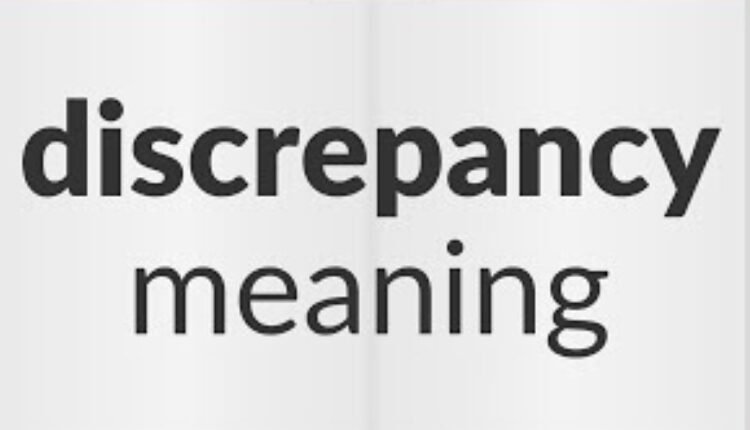Understanding the nuanced meaning of key terms is crucial in crafting effective policies that address contemporary challenges. One such term that plays a significant role in the development of sound policies is “discrepancy definition.” This concept refers to the differences that arise between ideal conditions and actual outcomes in various contexts, providing invaluable insight into policy gaps and failures. By systematically identifying and analyzing discrepancies, policymakers can create strategic frameworks that facilitate better alignment between objectives and results, ultimately leading to more effective governance.
The Importance of Defining Discrepancies
Defining discrepancies is not merely an academic exercise; it serves as the foundation for informed decision-making. When discrepancies are clearly identified, they illuminate areas that require attention or adjustment. For instance, in public health policies, a discrepancy between the expected health outcomes and the actual number of patients affected can highlight where interventions are failing or succeeding. Recognizing these gaps enables policymakers to allocate resources more effectively, target specific issues, and enhance overall outcomes.
Discrepancy Definition in Various Policy Domains
Education Policy
In the realm of education, a discrepancy definition can reveal significant divides in student performance across demographic groups. For instance, if there is a noted gap between the academic achievements of economically disadvantaged students and their more affluent peers, it calls for a reassessment of educational resources and opportunities. Addressing these discrepancies through well-targeted policies can lead to improvements in equity and educational outcomes for all students.
Environmental Policy
Environmental policies rely heavily on the identification of discrepancies between current environmental conditions and established sustainability goals. For example, if a country aims to reduce carbon emissions by 50% by a certain date but current trends indicate an upward trajectory instead, this discrepancy must be analyzed. Such an analysis can lead to the implementation of more stringent regulations, innovative technologies, and community engagement strategies to bridge the gap.
Tools for Identifying Discrepancies
Policymakers have access to various tools and methodologies for identifying discrepancies. Data analytics plays a central role in this process, allowing for the collection and examination of performance metrics. Surveys and public consultations can also provide qualitative insights, revealing the lived experiences of citizens and identifying gaps between perceived and actual policy efficacy. By integrating both quantitative and qualitative data, a comprehensive understanding of discrepancies emerges, guiding effective policy development.
The Role of Stakeholders
Collaboration among stakeholders is essential in the discrepancy definition process. Engaging various parties such as community members, industry experts, and non-profit organizations enriches the understanding of existing gaps. Diverse perspectives lead to more robust definitions of discrepancies and, therefore, more holistic policy responses. Policymakers must cultivate an inclusive dialogue to ensure all voices are heard, particularly those of marginalized communities that may be disproportionately affected by policy decisions.
Bridging Discrepancy Gaps
Once discrepancies are identified, the next step is bridging the gaps through innovative policy solutions. This may involve reforming existing structures, introducing new initiatives, or reallocating resources. For instance, in response to a discrepancy identified in healthcare access, policies could be developed to expand telehealth services, particularly in underserved areas. By directly addressing discrepancies, policies become more responsive and effective, ultimately benefiting the communities they serve.
Monitoring and Evaluation
Ongoing monitoring and evaluation are critical components of any policy development that seeks to address discrepancies effectively. This involves not only the initial identification of discrepancies but also assessing the impact of implemented policies over time. Establishing clear metrics and benchmarks allows policymakers to measure progress and adapt strategies as necessary. A continuous feedback loop ensures that policies remain relevant and effective, fostering an environment of accountability and responsiveness.
Challenges in Implementing Policies
Despite the importance of defining and addressing discrepancies in policy development, numerous challenges can hinder the effective implementation of these policies. One significant challenge is the resistance to change from various stakeholders, particularly when policies require alterations to established practices or resource allocations. Additionally, bureaucratic red tape can slow down the decision-making process, making it difficult for policymakers to respond promptly to identified discrepancies. Limited funding and resources may further complicate the enactment of innovative solutions, leading to stalled initiatives. Moreover, the dynamic nature of social and environmental factors means that discrepancies can shift over time, necessitating ongoing adjustments to policies that may not have been anticipated at the outset. To navigate these challenges, a proactive approach that fosters adaptability and stakeholder engagement is essential for ensuring that policies remain effective and responsive to the needs of communities.
Conclusion
In summary, defining discrepancies is crucial for effective policy development across various domains. By highlighting gaps between expected and actual outcomes, policymakers can make informed decisions that directly address the needs of the communities they serve. This process requires the integration of diverse data sources, active stakeholder engagement, and a commitment to continuous monitoring and adaptation. While challenges in implementation may arise, a proactive and inclusive approach can help bridge the gaps identified, leading to improved equity and outcomes across sectors. Ultimately, addressing discrepancies not only enhances the efficacy of policies but also fosters greater trust and collaboration between communities and decision-makers.



